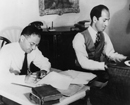All material found in the Press Releases section is provided by parties entirely independent of Musical America, which is not responsible for content.
Press Releases
Pianist Ian Hobson Online Recital Wednesday, July 22, 2020
The versatile and highly admired pianist and conductor Ian Hobson, whose playing has been described by Gramophone as “intensely alive to expressive nuance, textural clarity and elastic shaping,” will stream a carefully thought out program from his home in Florida, taking us through a journey of masterpieces from the young innocent Mendelssohn’s Andante and Rondo capriccioso, to the beautiful gems Liebesleid (Love’s Sorrow) and Liebesfreud (Love’s Joy) by Kreisler, arranged by Rachmaninoff.
The stream, co-presented by SubCulture NYC, Florida State University, and Sinfonia da Camera will go live on Subculture NYC's Vimeo on Wednesday, July 22nd, 2020, at 5:00 p.m. EDT (4:00 p.m. CDT, 3:00 p.m. MDT, 2:00 p.m. PDT, 10:00 p.m. UK, and 11:00 p.m. Europe).
Mendelssohn
Andante and Rondo capriccioso, Op. 14
Beethoven
Sonata in E-flat Major, Op. 31 No. 3
Chopin
Scherzo in E Major, Op. 54
Schumann
Papillons, Op. 2
Kreisler/Rachmaninoff
Liebesleid (Love’s Sorrow)
Liebesfreud (Love’s Joy)
Andante and Rondo capriccioso, Op. 14
Beethoven
Sonata in E-flat Major, Op. 31 No. 3
Chopin
Scherzo in E Major, Op. 54
Schumann
Papillons, Op. 2
Kreisler/Rachmaninoff
Liebesleid (Love’s Sorrow)
Liebesfreud (Love’s Joy)
Reached at his studio in his Tallahassee home, Mr. Hobson expressed his enthusiasm for the streamed recital repertoire:
Mendelssohn is the greatest child prodigy in musical history. His rondo capriccioso was written when he was 14 and remains one his most charming works. The andante which precedes it was added five years later. I was in my mid-20s when I first heard it.
I have studied and played the Beethoven Sonata, Chopin Scherzo, and Rachmaninov transcriptions since my mid-teens. The Beethoven is a sunny and optimistic work, totally different from the Tempest Sonata, Op. 31, No. 2, written at the same time—a time of great sadness for Beethoven and increasing deafness. Op. 31. No. 3 starts with a quizzical chord and has many surprises—the second movement is a scherzo in 2/4 time, the third a stately minuet and the fourth a fiery chase.
Chopin's 4th scherzo is the only one in a major key. The harmonies are quite new and exhilarating as are the cascades of scales and arpeggios. I think this piece became the initial inspiration for Liszt’s experiments after Chopin’s death.
Rachmaninov’s duo playing with the great violinist Fritz Kreisler gave rise to his complex and symphonic takes on the two simple waltzes of the original violin miniatures. They are extremely difficult to play but really contain the best of Rachmaninov’s piano writing.
Schumann’s Papillons is a musical depiction of the masked ball—a collection of waltzes and polonaises inspired by Schubert’s four-hand music and Jean Paul’ s fantastic novels. It begins with a reference to Weber’s most popular work “Invitation to the Dance.”
I look forward to playing it at my next Schumann series concert at Subculture.
Mendelssohn is the greatest child prodigy in musical history. His rondo capriccioso was written when he was 14 and remains one his most charming works. The andante which precedes it was added five years later. I was in my mid-20s when I first heard it.
I have studied and played the Beethoven Sonata, Chopin Scherzo, and Rachmaninov transcriptions since my mid-teens. The Beethoven is a sunny and optimistic work, totally different from the Tempest Sonata, Op. 31, No. 2, written at the same time—a time of great sadness for Beethoven and increasing deafness. Op. 31. No. 3 starts with a quizzical chord and has many surprises—the second movement is a scherzo in 2/4 time, the third a stately minuet and the fourth a fiery chase.
Chopin's 4th scherzo is the only one in a major key. The harmonies are quite new and exhilarating as are the cascades of scales and arpeggios. I think this piece became the initial inspiration for Liszt’s experiments after Chopin’s death.
Rachmaninov’s duo playing with the great violinist Fritz Kreisler gave rise to his complex and symphonic takes on the two simple waltzes of the original violin miniatures. They are extremely difficult to play but really contain the best of Rachmaninov’s piano writing.
Schumann’s Papillons is a musical depiction of the masked ball—a collection of waltzes and polonaises inspired by Schubert’s four-hand music and Jean Paul’ s fantastic novels. It begins with a reference to Weber’s most popular work “Invitation to the Dance.”
I look forward to playing it at my next Schumann series concert at Subculture.





 FEATURED JOBS
FEATURED JOBS

 RENT A PHOTO
RENT A PHOTO


